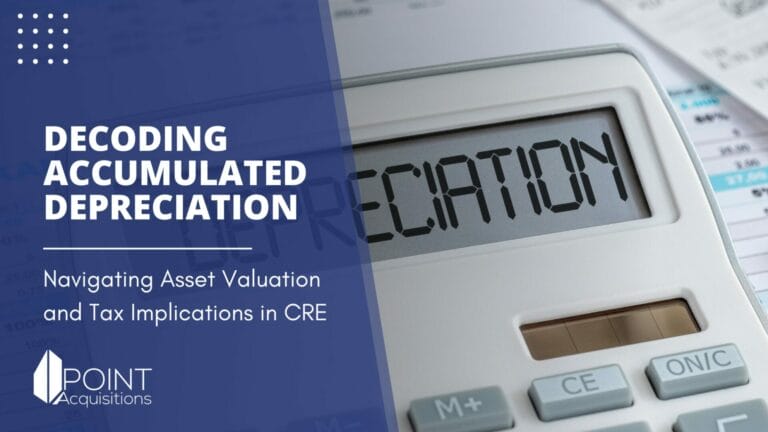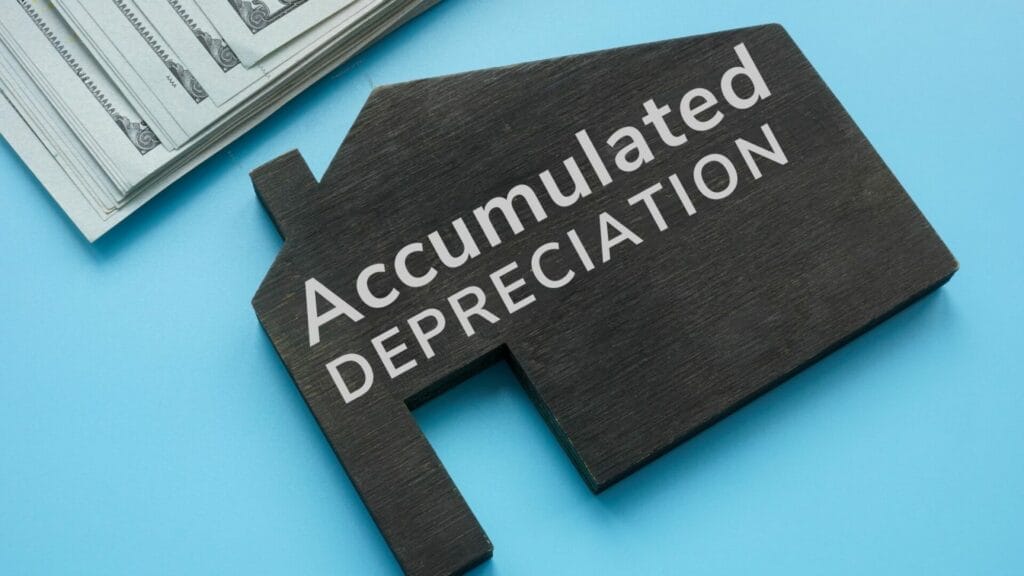
Understanding Accumulated Depreciation in Commercial Real Estate
In the dynamic world of Commercial Real Estate (CRE), understanding the concept of accumulated depreciation is important. This accounting process affects a property’s book value and influences crucial investment decisions and tax strategies.
Understanding accumulated depreciation and its nuances, such as depreciation expense and contra asset account, provides a clearer picture of an asset’s financial health and future potential. Whether evaluating the annual depreciation expense or considering the salvage value for tax purposes, knowledge of this area is key for CRE investors and sellers.

Table of Contents
Key Takeaways
- Accumulated depreciation is a key accounting concept in CRE, representing an asset’s gradual value reduction over time.
- It involves periodically allocating a portion of the cost of the asset as an expense over its useful life, affecting both the balance sheet and income statement of a business.
- This process helps understand the asset’s net book value, crucial for accurate financial reporting and investment analysis in CRE.
The Basics of Accumulated Depreciation in CRE
Accumulated depreciation is a fundamental accounting term in Commercial Real Estate (CRE). It refers to the total amount of depreciation expense that has been recorded against a fixed asset over its life. In simpler terms, it’s like a running tally of how much value an asset, such as a building, has lost over time due to use, wear and tear, and age.
In the world of CRE, accumulated depreciation is crucial. It shows on a credit balance sheet how much of an asset’s value has been used up. This is important for financial reporting, as it offers a more accurate picture of an asset’s worth. For tax purposes, it’s equally vital. It helps determine the depreciation expenses that can be deducted, impacting a business’s tax liabilities.
The Role of Depreciation in CRE Investments
Depreciation plays a key role in CRE investments. Every building and improvement on a property loses some of its value as time passes. This loss in value, or depreciation, affects an investment’s profitability. It reduces the income statement’s taxable income. This, in turn, can affect the cash flow and the overall return on investment.
But there’s a silver lining. Depreciation is a non-cash expense. This means it reduces reported income but doesn’t impact the cash flow. Smart investors use this to their advantage. Reducing taxable income through depreciation can improve cash flow while maintaining the property’s operational value.
Calculating Depreciation: Methods and Implications
There are several methods to calculate depreciation in CRE, each with its implications:
- Straight-Line Method: This is the simplest form. Here, the same amount of depreciation is recorded each year. It’s straightforward to understand. For CRE, this method spreads the asset’s cost evenly over its useful life.
- Accelerated Depreciation Methods: These include the Declining Balance Method and the Double Declining Balance Method. These methods record higher depreciation expenses in the early years of an asset’s life. Why use them? They can offer significant tax benefits upfront.
The choice of method impacts how CRE investments are reported and taxed. It influences the annual depreciation expense, the asset’s net book value, and the financial statements. CRE owners must consider these implications carefully. The right method matches with investment strategies, cash flow needs, and tax planning objectives.

Tax Reforms and Their Impact on CRE Depreciation
Recent tax reforms have significantly changed how depreciation is handled in Commercial Real Estate (CRE). The Tax Cuts and Jobs Act (TCJA) and the CARES Act are two major legislations that have reshaped the depreciation landscape. They’ve changed how depreciation expenses are calculated and how they can be used to get tax benefits.
Bonus Depreciation under TCJA and CARES Act
One of the key changes introduced by the TCJA is the concept of bonus depreciation. This allows CRE investors to deduct a larger portion of an asset’s cost immediately rather than spreading it over many years.
Here’s what it means: if you buy a property, you can immediately write off more of its cost. This change is great news for investors because it means bigger tax breaks in the early years of owning a property. It leads to accelerated depreciation, which can significantly improve cash flow in the short term.
Qualified Improvement Property (QIP) and Its Benefits
Another important aspect of these tax reforms is the focus on Qualified Improvement Property (QIP). QIP refers to any upgrades made inside a nonresidential building. Thanks to the TCJA, these improvements now have a shorter depreciation period and are eligible for bonus depreciation.
In simpler terms, if you renovate the interior of your office building, you can get tax benefits more quickly than before. This change makes investing in property improvements more attractive, as it can lead to faster tax deductions and, ultimately, better returns on investment.
Practical Examples and Case Studies
To understand how accumulated depreciation impacts Commercial Real Estate (CRE) investments, let’s dive into some practical examples and case studies. These real-life scenarios will demonstrate how different types of CRE investments benefit from strategic approaches to depreciation.
Small vs. Large Scale CRE Projects
In CRE, the scale of the project can greatly influence depreciation strategies. For instance:
- Small-scale projects: Consider a small retail space purchased for $1 million. A cost segregation study reclassifies significant portions of the property into shorter depreciation periods. This accelerates depreciation benefits, yielding greater tax savings in the initial years, which is crucial for smaller investors seeking quick returns.
- Large-scale projects: On the other hand, a $50 million commercial complex might have a different strategy. With a larger investment, the focus might shift to balancing immediate tax benefits with long-term financial planning. Here, a mix of straight-line and accelerated depreciation methods could be more beneficial, spreading tax advantages over a longer period and ensuring steady cash flow.
Considering Depreciation Recapture in Sales Strategies
When selling a CRE property, depreciation recapture is important. This is a tax provision where the IRS collects taxes on all or part of the depreciation expenses claimed. For example, if a property was purchased for $2 million and $500,000 in depreciation was claimed over the years, upon selling, the owner might have to pay taxes on that $500,000 as part of their sale proceeds.
- Impact on Sales: Understanding this concept is vital for CRE owners. It influences the sale price, as the potential tax liability from depreciation recapture could affect the net earnings from the sale.
- Strategic Sales Timing: Savvy investors often plan the sale of their assets considering the impact of depreciation recapture, sometimes aligning it with other investments or strategies to mitigate the tax impact.
Conclusion
In conclusion, accumulated depreciation in Commercial Real Estate (CRE) is more than just a routine accounting entry; it’s a strategic tool that can significantly impact investment decisions and tax planning.
Throughout this article, we’ve explored the basics of accumulated depreciation, its vital role in CRE investments, and the various methods used to calculate it. We’ve also looked into how recent tax reforms, specifically the TCJA and CARES Act, have reshaped depreciation strategies, emphasizing the importance of bonus depreciation and the benefits of Qualified Improvement Property (QIP).
Understanding and effectively using accumulated depreciation can lead to optimized tax benefits, better cash flow management, and informed decision-making in CRE investments. Please note this is not tax advice and should be used only for educational purposes, you should consult a tax professional on all tax related matters.

FAQs
What is an accumulated depreciation account?
An accumulated depreciation account is a contra asset on a company’s balance sheet. It represents the total amount of depreciation expense that has been recorded over the life of a fixed asset.
How do you calculate accumulated depreciation?
To calculate accumulated depreciation, you need to multiply the depreciation rate by the asset’s cost and then by the years the asset has been in use.
What are fixed assets in the context of CRE?
In CRE, fixed assets refer to long-term tangible assets, like buildings and land improvements, used in the company’s operation.
How is depreciation expense recorded in CRE?
Depreciation expense is recorded annually on the income statement, reflecting the property’s wear and tear or obsolescence over time.
What does accumulated depreciation refer to?
Accumulated depreciation refers to the cumulative depreciation applied to a fixed asset over its useful life.
How is total depreciation different from annual depreciation?
Total depreciation is the aggregate depreciation expense recorded for an asset since its purchase.
About The Author

Jesse Shemesh
Disclaimer
Please note that Point Acquisitions is not a tax expert or tax advisor. The information on our blogs and pages is for general informational purposes only and should not be relied upon as legal, tax, or accounting advice. Any information provided does not constitute professional advice or create an attorney-client or any other professional relationship. We recommend that you consult with your tax advisor or seek professional advice before making any decisions based on the information provided on our blogs and pages. Point Acquisitions is not responsible for any actions taken based on the information provided on our blogs and pages.
1031 Exchange Capital Gains Tax Deferral
According to a 2021 report by the National Real Estate Exchange Services (RES), over 240,000 1031 exchange transactions were completed in the United States, totaling $100 billion. This impressive figure underscores the role of 1031 exchanges in the real estate…
Read More1031 Exchange Benefits
As of Q4 2023, the national vacancy rate for all commercial property types in the United States sat at 9.2%, according to CBRE’s latest insights and research. This represents a slight decrease compared to the previous quarter and suggests a…
Read More1031 Exchange Legal Considerations: A Must-Read Guide
You’re in the right place if you’re considering a 1031 exchange for your commercial real estate investments. Whether you’re a seasoned investor or just dipping your toes into the market, understanding the legal landscape of 1031 exchanges is key to…
Read More

